I wanted to explain and source everything correctly, that said some are more sourced than others. Some sections are entirely written by me and others take a line or two form Wikipedia and About.com. There are personal notes in each section.
Although this leaves me with a wall of text feeling, but again, I still feel it needs to be done.
Let's begin.
 |
| (Source) |
"Manga is the Japanese word for "comics/cartoons" and consists of comics and print cartoons. In the West, the term "manga" has been appropriated to refer specifically to comics created in Japan or by Japanese authors in the Japanese language and conforming to the style developed in Japan in the late 19th century. In their modern form, manga date from shortly after World War II.
In Japan, people of all ages read manga. The medium includes works in a broad range of genres: action-adventure, romance, sports and games, historical drama, comedy, science fiction and fantasy, mystery, horror, sexuality, and business/commerce, among others. Since the 1950s, manga has steadily become a major part of the Japanese publishing industry. Manga have also gained a significant worldwide audience.
Manga stories are typically printed in black-and-white, although some full-color manga exist. In Japan, manga are usually serialized in large manga magazines, often containing many stories, each presented in a single episode to be continued in the next issue. If the series is successful, collected chapters may be republished in paperback books called "tankobon" (volume). If a manga series is popular enough, it may be animated after or even during its run, although sometimes manga are drawn centering on previously existing live-action or animated films." (Source)
What do you know about manga and it's influence?
 |
| (Source) |
In the United States, people refer to what they perceive as manga "styled" comics as Amerimanga (which I have never heard), world manga, or original English-language manga (OEL manga). Still, the original term "manga" is primarily used in English-speaking countries solely to describe comics of Japanese origin. More Information
Tokyo Pop used to hold a contest called The Rising Stars of Manga. Where they would print volumes with the winners of each contest, display their entries along with a small profile of the writers and authors. (This is no longer being held but I remember them and thought I would mention as many artists have gone on to do other works and hair their works printed.)
Some of the ones I know of are Van Von Hunter, Bizenghast (Seriously amazing art style), Mark of the Succubus, and Sorcerers & Secretaries.
Around the world: More Information on manga in Brazil, France, Germany, Indonesia, Australia, New Zealand, Russia, Thailand, the United States, and manga influences around the world.
Now that we have the specifics out of the way, I usually just refer to all of them as "mangas". I feel in the big scheme of things those titles or names don't usually matter all that much. None the less it's good to know when searching for or referring to a series. Such as a Manhwa should be stated as at least being of Korean origin and not simply as being a "manga".
For the most part, and the rest of this post, I will refer to "mangas" as a whole. Mainly because it's easier and should now be more understood.
Demographic groups:
The most common groups are Shonen and Shojo, however many people don't know there are subgroups of each. While both Shonen and Shojo are targeted at 'younger' groups (around and below 18.) these subgroups are considered to be more 'realist'
Shonen has Seinen, which can be tricky to explain because some of them cross over into the pornographic area, however that is not the only kind that can be labeled as Seinen.
Shojo has Josei, again considered to be more 'realist'; tackling everyday life and situations while avoiding elements you might find in shojo, such as magical girls.
- The term Shōnen, shonen, or shounen manga literally means "young person's comic" or simply "boys comic".
 |
| YuYu Hakusho (Source) |
Some shonen examples include: Dragon Ball Z, Detective Conan, YuYu Hakusho, InuYasha, Naruto, Bleach, Soul Eater, The Prince of Tennis, and Fullmetal Alchemist. (Source)
- Seinen is considered to be a subset of the manga genres, generally targeted at a 18–30 year old male audience but the audience can be older with some manga aimed at businessmen well into their 40s. In Japanese, the word Seinen means "young man" or "young men" and is not suggestive of sexual matters.
 |
| Battle Angel Alita (Source) |
Because of the emphasis on storyline and character development as apposed to action some seinen series can be confused with shojo.
Some examples include: Battle Royale, Ghost in the Shell, Akira, Berserk, Battle Angel Alita, and Elfen Lied. (Source)
 |
| Fushigi Yugi (Source) |
- Shōjo, shojo, or shoujo manga is marketed towards a female audience roughly between the ages of 10 and 18. The name romanizes in Japanese , literally "little female".
Examples include Cardcaptors, Fruits Basket, Fushigi Yuugi, Ouran High School Host Club, Sailor Moon, Skip Beat, and Vampire Knight. (Source)
- Josei manga also known as "ladies" or "ladies' comics", a term which refers to the targeted demographic of manga for women in their late teens and adulthood. General reading audiance is considered to be within the rage of 15-44. In Japanese, the word josei means simply "woman", "female", "feminine", "womanhood" and has no manga-related connotations at all.
 |
| Paradise Kiss (Source) |
Josei can portray romance, as opposed to the mostly idealization of romance found in shojo. Josei also tends to be sexually explicit and contain mature storytelling, although not always true. It is also common for themes of sexual topics, plots, and situations to be found in josei. As it's targeted for a more mature audience.
Some examples include: Loveless and Paradise Kiss. (Source)
Children's manga/anime is often called "Kodomomuke". "Kodomo" means "child". (Source)
Sadly I have no personal notes to add as I have never encountered a children's manga.
Genres:
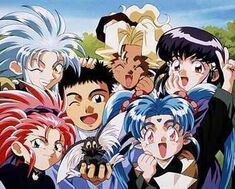 |
| Tenchi Muyo! (Source) |
- Harem, hāremumono, is loosely considered to be a sub-genre of anime and manga characterized by a protagonist surrounded, usually amorously, by three or more members of the opposite sex. It's considered to be more that a male be surrounded by a group of females, although when this is reverse (a women surrounded by men) it's known as a reverse harem.
- Magical girls also belong to a sub-genre of Japanese fantasy found in anime and manga. Magical girl stories feature young girls with superhuman abilities, forced to fight evil and usually protecting the Earth in the process. Often possessing secret identities although some plots involve magic and transformation sequences (such as Full Moon o Sagashite and Sailor Moon) avoiding the process of hiding their "true" identity all together.
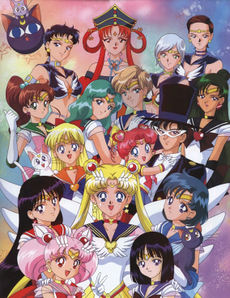 |
| Sailor Moon (Source) |
- Magical boys occur much more rarely, but one can readily identify them: they operate along similar lines (as with D.N.Angel). (Source)
 |
| Gundam Wing (Source) |
- Mecha covers all series involving or revolve around the use of [often] piloted robotic armors, usually in battle. Which can be mostly brokwn down into two subcategories; Super Robot and Real Robot. Mecha cover a wide variety of genres from comedy to drama, although they are always fantastical with a larger-than-life nature and feature large-scale battles and action sequences. (Source)
- Yaoi, also known as Boys' Love, is a term for [mostly] female-oriented media that focus on homoerotic or homo-romantic male relationships, many of which are by female authors. (Manga aimed at a gay male audience is considered a separate genre.)
 |
| Gravitation (Source) |
Parodies of this dynamic has been found in other anime and manga works belonging to the genre of yaoi.
Such yaoi parodies can be found in, Captain Tsubasa and Saint Seiya. (Source)
 |
| Strawberry Panic! (Source) |
- Yuri, also known as Girls' Love, a term for content that involves love, relationships, between women. Yuri can focus on the sexual, the spiritual, or the emotional aspects of those relationship. (The themes yuri deals with have their roots in the Japanese lesbian literature of early twentieth century.)
Some examples include, Kannazuki no Miko and Strawberry Panic! (Source)
Personally I don't see much Yaoi or Yuri no doubt to it not being my preference, but of course they do exist in the world.
Finding, Buying, Accessibility
- Manga is by far the easiest to find, to learn about, to buy. It is literally everywhere. You can go to any book store and pick up a manga. Which is why I actually won't talk about it.
- Manhwa, is hard to find. From time to time you might be able to find one, but most likely you may have never seen any or only seen one. I don't know what it is, but Korean mangas don't make it anywhere (store wise). They're style is different, the stories are usually romance (at least the ones I've seen around but it's also what I prefer), and the books themselves are different. If you have never seen a manhwa before, they are sometimes larger. The book is a different size, which makes the images are usually larger overall. (Some have been formatted now to typical mangas, such as I.N.V.U.) But they are difficult to find! You're best probably ordering them online.
- Manhua, I have never seen let alone READ a manhua. At least I'm fairly sure I haven't. I don't know if they even translate or print them in the United States Manhua's don't seem to make it over here
Magazines
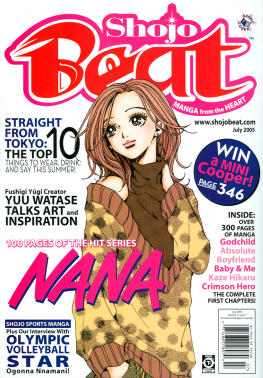 |
| (Source) |
Rather then go on about them, as that really isn't my point and many of them are no longer in print in the United States, I'll leave that here for you to look at yourself.
More Information: List of Manga Magazines
I have personally subscribed to both Smile and Shojo Beat which were were based around romance and more girl-friendly mangas. Both of them are now out of print. *sadface*
Reading Format
 |
| (Source) |
"Manga usually follows the traditional style as found in Japan. Japanese
Manga is to be read from the right side to the left, opposite of
traditional American books. Not only do you read the pages from right to
left, but you also read the panels and text from right to left. There
have been attempts to make Manga published in America to look and read
like traditional American books, but many artists have opposed this. The
fans of Manga have also been a part of making sure that many Manga
produced in America today is in the traditional Japanese style." (Source)
Before mangas in the United States reached the format you see now, they did originally flip the images to be read left-to-right. I have a few of these older mangas and it's strange to see why they did that at first. I'm assuming since that's how English speaking countries read they felt it would be easier to do so. Although in the end it was found to be more work and real fans (aka elitists) complained against changing the original format.
Personally either way doesn't bother me much but I have gotten used to reading mangas right-to-left over time.
Art Style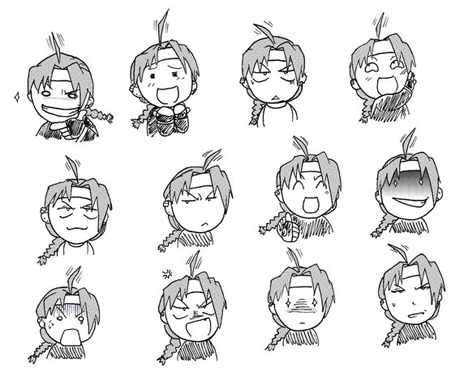 |
| (Source) |
I feel that each country of origin has similar styles that seem to emerge from countries, although each artists it's self has their own style.
 |
| Goong/Palace (Source) |
(See image) Do you see what I mean?
Where as I find typically the Japanese to be very cute and bubbly, but not always.
I found a post that had a poll for the style people refer (with examples) here's what they listed. (Poll)
- Old-school (Anatolia Story/Ranma 1/2)
- Manhwa (Kill Me Kiss Me/Ciel)
- Big-eyed shoujo (Chocolate Cosmos/Gentlemen's Alliance
- Real Life (NANA/Tsubasa RC)
- Abstract (The Demon Ororon/Syonara Zetsubou Sensei)
- Anime (Persona 3/Most hardcore ecchi/hentai)
- Modern (Special A/S no Yuiitsu M no Zettai)
 | |||
| Chinese Hero: Tales of the Blood Sword | (Source) |
I find the Chinese style to much more realist looking. Where as I've said I have never seen one I do see the style floating around a bit.
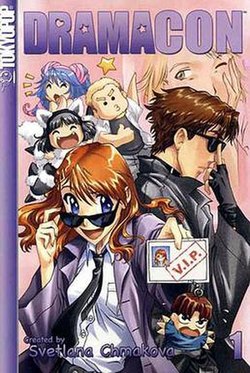 |
| Dramacon (Source) |
I choose to feature Dramacon as it's considered one of the best OEL mangas around and it's a personal favourite of mine. (See influences for more details about OEL mangas.)
Done!
Now that I've rambled on and probably bored everyone to death, I apologize. I realize how long this post is and how much information it contains. Although I feel a very large weight has been lifted from my shoulders I can continue my Asian Rama series.Next we will be talking about Asian Dramas!
Note: Genre sections are sourced from Wikipedia. While writing this post I did stumble across Manga 101 at About.com (see Reading Format). These sites both helped and inspired this post.
For most information, and better writing, please see those links respectively.
No comments:
Post a Comment